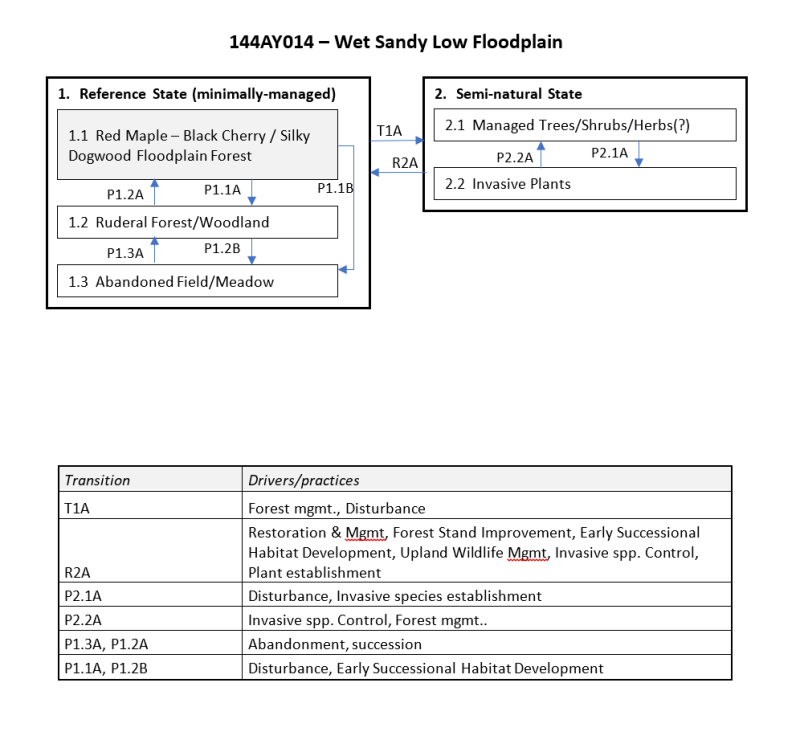
Natural Resources
Conservation Service
Ecological site F144AY014CT
Wet Sandy Low Floodplain
Last updated: 10/04/2024
Accessed: 12/21/2025
General information
Provisional. A provisional ecological site description has undergone quality control and quality assurance review. It contains a working state and transition model and enough information to identify the ecological site.
MLRA notes
Major Land Resource Area (MLRA): 144A–New England and Eastern New York Upland, Southern Part
MLRA 144A: New England and Eastern New York Upland, Southern Part
The eastern half of the eastern part of this MLRA is in the Seaboard Lowland Section of the New England Province of the Appalachian Highlands. The western half of the eastern part and the southeastern half of the western part are in the New England Upland Section of the same province and division. The northwestern half of the western part is in the Hudson Valley Section of the Valley and Ridge Province of the Appalachian Highlands. This MLRA is a very scenic area of rolling to hilly uplands that are broken by many gently sloping to level valleys that terminate in coastal lowlands. Elevation ranges from sea level to 1,000 feet in much of the area, but it is 2,000 feet on some hills. Relief is mostly about 6 to 65 feet in the valleys and about 80 to 330 feet in the uplands.
This area has been glaciated and consists almost entirely of till hills, drumlins, and bedrock-controlled uplands with a mantle of till. It is dissected by narrow glacio-fluvial valleys. The southernmost boundary of the area marks the farthest southward extent of Wisconsinian glaciation on the eastern seaboard. The river valleys and coastal plains are filled with glacial lake sediments, marine sediments, and glacial outwash. The bedrock in the eastern half of the area consists primarily of igneous and metamorphic rocks of early Paleozoic age. Granite is the most common igneous rock, and gneiss, schist, and slate are the most common metamorphic rocks. In the parts of the MLRA in eastern and southeastern New York, Devonian- to Pennsylvanian-age sandstone, shale, and limestone are dominant. Carbonate rocks, primarily dolomite and limestone, are the dominant kinds of bedrock in the part of this MLRA in northwestern Connecticut.
Classification relationships
USDA-NRCS (USDA 2006):
Land Resource Region (LRR): N—East and Central Farming and Forest Region
Major Land Resource Area (MLRA): 144A— New England and Eastern New York Upland, Southern Part.
USDA-FS (Cleland et al. 2007)
Province: 221 - Eastern Broadleaf Province
Section: 221A - Lower New England
Subsection: 221Aa – Boston Basin
221Ac – Narragansett-Bristol Lowland and Islands
221Ad – Southern New England Coastal Lowland
221Ae – Hudson Highlands
221Ag - Southeast New England Coastal Hills and Plains
221Ah - Worcester-Monadnock Plateau
221Ai – Gulf of Maine Coastal Plain
221Ak - Gulf of Maine Coastal Lowland
Section: 221B – Hudson Valley
Subsection: 221Ba – Hudson Limestone Valley
221Bb - Miami – Taconic Foothills
221Bc – Hudson Glacial Lake Plains
Ecological site concept
The Wet Sandy Low Floodplain ecological site consists of deep, coarse-loamy, poorly drained, alluvial soils on low floodplains of mostly small to medium sized river valleys but can also be found within large river valleys. These floodplains are subject annual flooding. Water is at or near the surface for much of the growing season. Representative soil is Rippowam.
The reference plant community is considered to be an alluvial red maple dominated forest. Red maple (Acer rubrum) dominates with occasionally American elm (Ulmus americana). At higher elevations in the flood profile may be found American sycamore (Platanus occidentalis), black cherry (Prunus serotina), American hornbeam (Carpinus caroliniana var virginiana). Silky dogwood (Cornus amomum) is a typical shrub. The understory is diverse with many ferns, sedges and herbs.
Common invasive exotic plants are honeysuckles (Lonicera spp), moneywort (Lysimachia nummularia), garlic mustard (Alliaria petiolate) and Japanese stiltgrass (Microstegium viminium).
Associated sites
| F144AY012CT |
Sandy Low Floodplain |
|---|---|
| F144AY016MA |
Very Wet Low Floodplain |
Similar sites
| F144AY006CT |
High Floodplain Levee |
|---|---|
| F144AY042NY |
Semi-Rich Organic Wetlands |
Table 1. Dominant plant species
| Tree |
(1) Acer rubrum |
|---|---|
| Shrub |
(1) Viburnum dentatum |
| Herbaceous |
(1) Onoclea sensibilis |
Click on box and path labels to scroll to the respective text.
